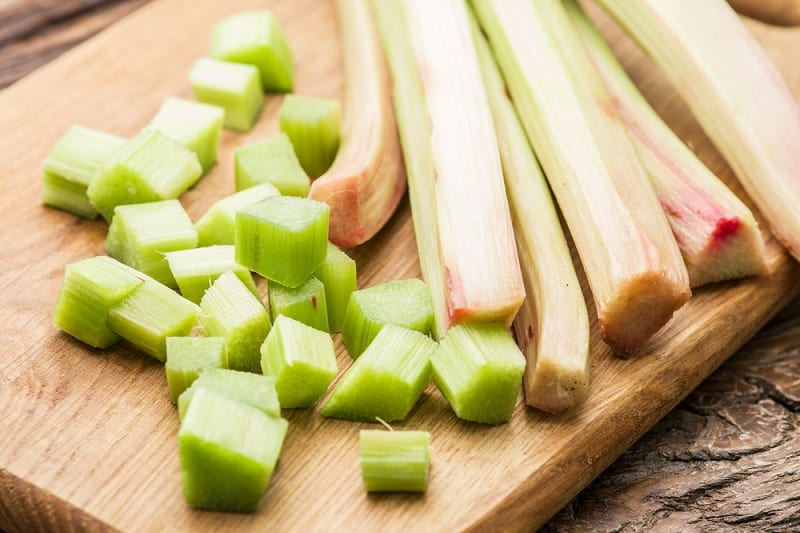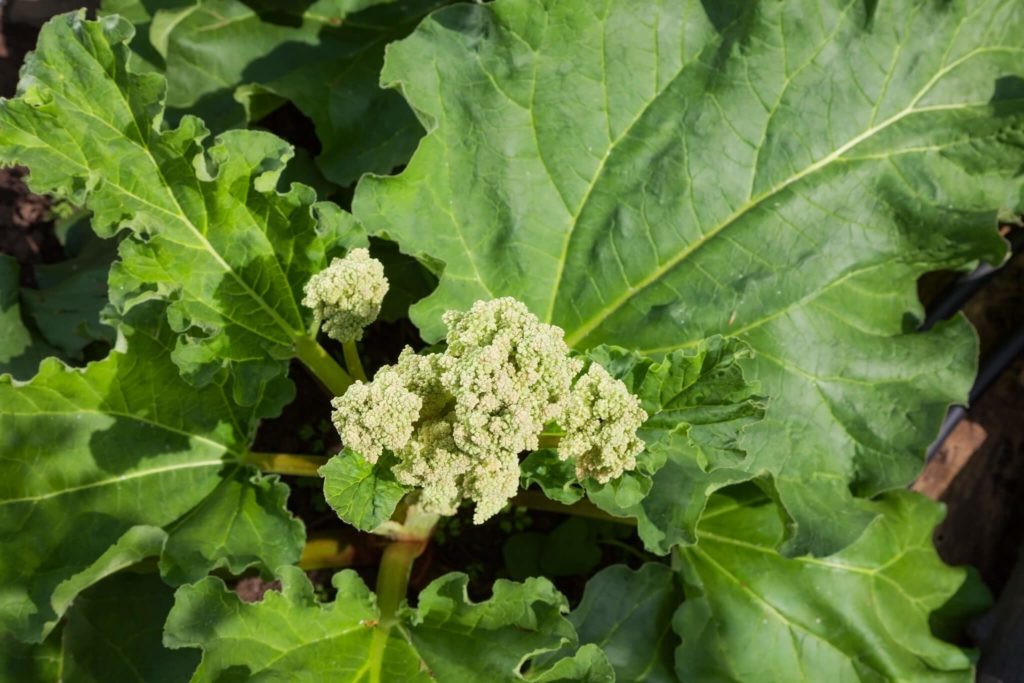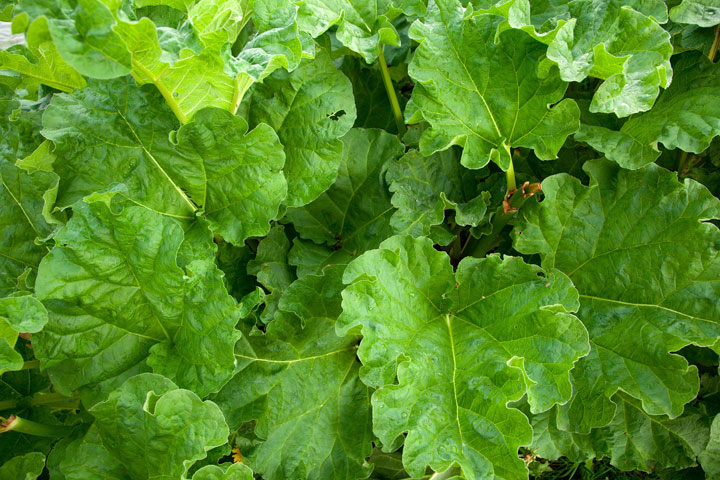Your rhubarb is green either because it is a green-stalked variety or because it may be harvested before the stalks have a chance to turn red.
Rhubarb is green when it lacks exposure to sunlight. To encourage red coloration, ensure the plant receives adequate sunlight, typically at least 6 hours of direct sunlight per day.
Introduction on Why Is My Rhubarb Green
Red rhubarb is a popular and distinctive vegetable known for its vibrant crimson stalks and tart flavor.
Red rhubarb has become a staple in many kitchens, widely used in culinary applications, particularly in pies and jams.
However, the unexpected appearance of green rhubarb can raise both curiosity and concern among those familiar with its more common red hue.
Typically, the common expectation of red rhubarb stems from its characteristic appearance, with bright red or pink stalks and large green leaves.
The striking coloration not only adds visual appeal to dishes but also signals the vegetable’s maturity and readiness for harvest.
Varieties of Rhubarb:

Rhubarb, a versatile and widely cultivated vegetable, comes in various varieties, each with its own unique characteristics.
One of the primary distinctions among these varieties lies in the color of their stalks, with both red and green-stalk rhubarb being commonly found.
Red-Stalked Varieties: The most familiar type of rhubarb is characterized by its vibrant red or pink stalks. Varieties such as ‘Victoria’ and ‘Crimson Cherry’ fall into this category.
The deep red color is often associated with a higher level of sweetness and is a critical feature that makes red rhubarb a popular choice for culinary applications.
Green-Stalked Varieties: Contrary to the more prevalent red varieties, there are also rhubarb types with green stalks.
Examples of green-stalked varieties include ‘Glaskins Perpetual’ and ‘Timperley Early.’ The green coloration can vary from a light green to a deeper, more intense shade.
Green-stalk rhubarb tends to have a slightly different flavor profile, often featuring a more pronounced tartness compared to its red counterparts.
Diversity in Rhubarb Types: The diversity in rhubarb varieties goes beyond just the color of the stalks. Factors such as taste, texture, and harvest times can also vary among different types.
The choice between red and green varieties allows for culinary experimentation, enabling chefs and home cooks to tailor their dishes based on personal preferences.
Factors Influencing Stalk Color: The color of rhubarb stalks is influenced by a combination of genetic factors and environmental conditions.
While some varieties are inherently red or green, others may display variations in color based on factors like sunlight exposure, soil conditions, and temperature.
Understanding these influences adds another layer of complexity to the world of rhubarb, making it an intriguing subject for both gardeners and culinary enthusiasts.
In conclusion, the diverse array of rhubarb varieties, encompassing both red and green-stalked types, contributes to the vegetable’s appeal and versatility.
Exploring these variations adds excitement to the culinary experience and underscores the dynamic interplay between nature and nurture in shaping the characteristics of this beloved vegetable.
Maturity Matters:
One of the fascinating aspects of rhubarb growth is the intriguing transformation of its stalk color as it matures.
Rhubarb stalks typically emerge as green when they first sprout from the crown of the plant.
However, as these stalks mature, they gradually change color, evolving from green to the vibrant red or pink hue commonly associated with fully mature rhubarb.
Anthocyanins and the Color-Changing Process:
The key players in this remarkable color transformation are pigments known as anthocyanins.
Anthocyanins are pigments that dissolve in water. They’re in the cells of rhubarb stalks and are the reason why lots of fruits and veggies have red, purple, or blue colors.
As rhubarb stalks mature, the levels of anthocyanins increase. Various factors, including exposure to sunlight and temperature fluctuations influence this accumulation.
The process is a response to environmental cues and serves multiple purposes.
Anthocyanins not only contribute to the attractive red coloration of the stalks but also play a protective role, acting as antioxidants that help the plant defend against stressors such as UV radiation.
The color-changing process is not uniform across all rhubarb varieties, and some may exhibit more pronounced red hues than others.
Additionally, environmental conditions, such as cooler temperatures, can enhance the production of anthocyanins, intensifying the red coloration.
Sign of Readiness for Harvest:
The progression from green to red in rhubarb stalks is not just visually appealing but also indicates the plant’s readiness for harvest.
Fully mature rhubarb stalks, with their vibrant red color and increased anthocyanin content, are generally considered to be at their peak in terms of flavor and sweetness.
Harvesting rhubarb at the right stage ensures a balance between tartness and sweetness in culinary applications.
As such, gardeners and farmers often wait for the majority of the stalks to turn red before harvesting, signaling that the rhubarb has reached an optimal level of maturity.
In conclusion, the color-changing journey of rhubarb stalks from green to red as they mature is a captivating process driven by the dynamic interplay of anthocyanins and environmental factors.
This transformation not only enhances the aesthetic appeal of the vegetable but also provides valuable cues for those cultivating and enjoying this unique and versatile plant.
Growing Conditions and Color:
Rhubarb’s color isn’t just because of its natural genes; the way it looks is also influenced a lot by the environment.
Two crucial environmental factors that influence rhubarb color are temperature and sunlight exposure.
1. Temperature:
Cooler temperatures are often associated with the development of more intense red hues in rhubarb stalks.
In cooler spring and early summer weather, the plant produces more anthocyanins, which are the pigments responsible for the red color.
This phenomenon is part of the plant’s response to environmental stress.
In colder climates or during cooler periods, rhubarb plants may produce higher concentrations of anthocyanins as a protective mechanism.
These pigments act as antioxidants, helping the plant mitigate the effects of stressors such as UV radiation. Consequently, rhubarb stalks exposed to cooler temperatures may display richer and deeper shades of red.
2. Sunlight Exposure:
Sunlight exposure is another critical factor influencing rhubarb color. Adequate exposure to sunlight is essential for the synthesis of anthocyanins.
Rhubarb plants grown in locations with ample sunlight tend to produce more of these pigments, contributing to the development of a vibrant red color in the stalks.
The process is akin to a sun-induced chemical reaction.
When rhubarb plants receive sufficient sunlight, the chlorophyll in the leaves helps capture light energy, and this energy is then utilized in the production of anthocyanins in the stalks.
This not only enhances the visual appeal of the rhubarb but also serves a protective function for the plant.
In contrast, rhubarb plants in shaded or less sunny environments may produce fewer anthocyanins, resulting in stalks that are less red and greener.
Insufficient sunlight can hinder the optimal synthesis of these pigments, impacting the rhubarb’s color and potential antioxidant benefits.
In summary, the color of rhubarb is intricately linked to the interplay between genetic factors and the environment.
Cooler temperatures and increased sunlight exposure tend to promote the development of rich red hues, making these environmental conditions key considerations for those looking to cultivate rhubarb with the most vibrant and appealing coloration.
Culinary Implications:
While red rhubarb is more commonly associated with its vibrant color and sweet-tart flavor, it’s essential to reassure readers that green rhubarb is equally edible and can be used in a variety of recipes.
The green coloration does not indicate any safety concerns or a lack of ripeness; rather, it signifies a different variety or specific growing conditions.
Edibility of Green Rhubarb: Green rhubarb is perfectly safe to eat, and its culinary applications are similar to those of red rhubarb.
The stalks can be harvested and used in a range of recipes, including pies, jams, sauces, and desserts. The green color does not compromise the quality or taste of the rhubarb.
Taste Differences: While the visual difference between green and red rhubarb is apparent, there may be subtle variations in taste. Green rhubarb tends to have a slightly stronger, more pronounced tartness compared to its red counterpart.
This difference in flavor can add an interesting dimension to dishes, allowing for a balance of sweetness and tartness that may be preferred in certain culinary creations.
Culinary Creativity:
The use of green rhubarb opens up opportunities for culinary creativity. Its unique flavor profile can be harnessed in recipes where a more intense tartness is desired.
It can also be combined with sweeter ingredients to achieve a well-balanced and nuanced taste in dishes. The versatility of rhubarb, whether green or red, allows for experimentation in the kitchen, letting cooks tailor their recipes to personal preferences.
In summary, green rhubarb is a viable and flavorful culinary option. Its slightly different taste can be an asset in certain recipes, providing a twist on the classic rhubarb flavor.
So, whether your rhubarb is red or green, embrace the diversity of this versatile vegetable and explore the multitude of delicious dishes you can create with it.
Addressing Concerns:
It’s not uncommon for individuals to have concerns when encountering green rhubarb, especially if they are more accustomed to the vibrant red variety.
Acknowledging these concerns and reassuring that the green coloration is often a natural and normal part of the rhubarb growth process is important.
Common Concerns: One common concern is whether green rhubarb is safe to eat or if its color indicates some sort of ripeness issue.
Additionally, there might be worries about potential differences in taste or nutritional content compared to the more familiar red rhubarb.
Natural Growth Process: It’s crucial to emphasize that green rhubarb generally results from the natural growth process and does not indicate any safety or quality concerns.
Rhubarb stalks start off green and gradually turn red as they mature. Factors such as genetics, environmental conditions, and specific varieties contribute to the color variations observed in rhubarb.
Taste and Nutritional Quality: Reassure readers that the green color does not compromise the taste or nutritional quality of the rhubarb.
While there might be subtle differences in taste between green and red rhubarb, both varieties are edible and can be used interchangeably in recipes.
Encouraging Exploration: Encourage individuals to embrace the diversity of rhubarb varieties and to see green rhubarb as an opportunity for culinary exploration.
Its unique taste profile can add a delightful twist to dishes, and by incorporating both red and green rhubarb, one can create a broader range of flavors and visual appeal in their culinary creations.
In conclusion, addressing concerns about green rhubarb involves providing information about its natural growth process and dispelling any worries about its safety or quality.
By fostering an understanding of the diverse characteristics of rhubarb, individuals can confidently enjoy the culinary possibilities that both red and green varieties offer.
Ornamental vs. Culinary Rhubarb: Differences Between Ornamental and Culinary Rhubarb:

Beyond the realm of culinary delights exists a lesser-known but equally captivating variety of rhubarb—ornamental rhubarb.
Unlike its culinary counterpart, which is primarily grown for its edible stalks, ornamental rhubarb varieties are cultivated for their aesthetic appeal, making them an intriguing addition to gardens and landscapes.
Primary Purpose:
Culinary Rhubarb: Grown primarily for its edible stalks, culinary rhubarb is cultivated with a focus on flavor, texture, and versatility in the kitchen.
The vibrant red or green stalks are the star of the show, and their taste is a key consideration.
Ornamental Rhubarb:
People grow ornamental rhubarb in gardens and landscapes because it looks good. It stands out for its leaves, how it grows, and how it looks.
While some ornamental varieties may produce edible stalks, they are not the main attraction.
Appearance:
Culinary Rhubarb: Typically characterized by large, robust stalks with vibrant red or green coloration, culinary rhubarb varieties often have broad, attractive leaves. The focus is on the practicality of the edible stalks.
Ornamental Rhubarb: Features such as unique leaf shapes, colors, and patterns take center stage in ornamental varieties. Some ornamental rhubarbs may have strikingly colored or variegated leaves, contributing to their visual appeal.
Edibility:
Culinary Rhubarb: Valued for its culinary applications, the stalks of culinary rhubarb are harvested for use in pies, jams, and other dishes. The flavor and texture of the stalks are key considerations.
Ornamental Rhubarb: While some ornamental rhubarb varieties may produce stalks that are technically edible, they are often less palatable or more fibrous than those of culinary varieties.
The plant’s overall visual impact is emphasized rather than its edibility.
Cultural Practices:
Culinary Rhubarb: Grown in traditional vegetable gardens or designated rhubarb patches, culinary rhubarb requires care and attention to ensure optimal stalk production. Regular harvests are a common practice.
Ornamental Rhubarb: People plant ornamental rhubarb in gardens and landscapes because it adds texture, color, and interesting shapes to garden beds.
The emphasis is on the overall aesthetics of the plant.
In summary, the distinction between ornamental and culinary rhubarb lies in their primary purpose and emphasis on visual appeal or culinary utility.
While culinary rhubarb steals the spotlight in the kitchen, ornamental varieties take center stage in the garden, offering a different kind of beauty and charm to horticulturists and landscape enthusiasts.
FAQs
Why is my rhubarb green instead of red?
Green rhubarb is a common variety, and its color is primarily determined by the specific cultivar you are growing.
Is green rhubarb safe to eat?
Yes, green rhubarb is safe to eat. It has a slightly different flavor than red rhubarb but is equally delicious.
Can the color of rhubarb change as it matures?
Yes, the color of rhubarb can change as it matures, and some green varieties may turn slightly red or pink as they grow.
Does the color of rhubarb affect its taste?
While the color of rhubarb can influence its taste slightly, both green and red varieties have a tart flavor commonly associated with rhubarb.
Why is my rhubarb stalk only partially red?
Partial redness in rhubarb can be influenced by factors such as exposure to sunlight, genetics, or the specific cultivar. It’s normal to have variation in color.
Can I turn green rhubarb red during growth?
You cannot change the color of rhubarb stalks during growth. The genetics of the plant predetermines the color.
Does green rhubarb have the same nutritional benefits as red rhubarb?
Yes, both green and red rhubarb have similar nutritional profiles, rich in vitamins, minerals, and antioxidants.
Is there a difference in sweetness between green and red rhubarb?
Yes, there are differences in sweetness between green and rhubarb.
Red rhubarb is often considered slightly sweeter than green rhubarb, but the overall sweetness can vary based on factors like growing conditions and harvest time.
Can environmental factors affect the color of rhubarb?
Yes, exposure to sunlight can influence the color of rhubarb. Rhubarb that receives more sunlight may develop more vibrant red hues.
Are there specific varieties of rhubarb that are always green?
Yes, some rhubarb varieties, such as the “Victoria” cultivar, are naturally green and do not turn red as they mature.
Should I harvest green rhubarb differently than red rhubarb?
Harvesting practices for green rhubarb are generally the same as for red rhubarb. Wait until the stalks are of sufficient size, and then harvest by pulling or cutting them near the base.
Conclusion
The world of rhubarb extends beyond its culinary applications to embrace the ornamental realm.
While culinary rhubarb entices with its vibrant stalks and delectable taste, ornamental varieties captivate with unique foliage and visual allure.
Whether adorning a plate or enhancing a garden landscape, culinary and ornamental rhubarb contribute to this versatile plant’s diverse and fascinating tapestry.

